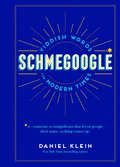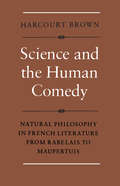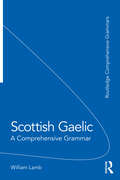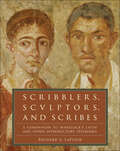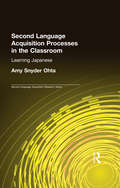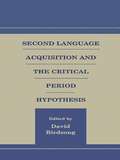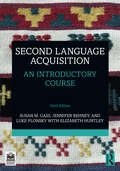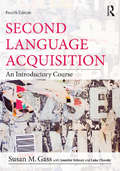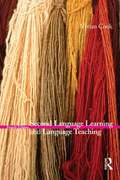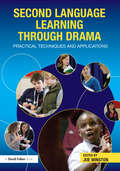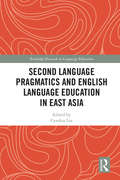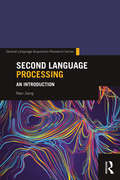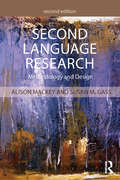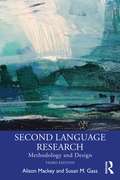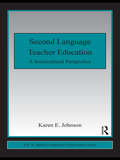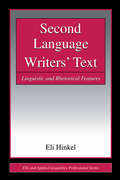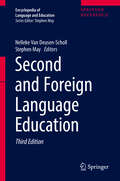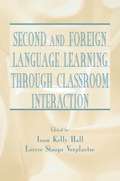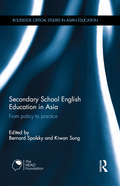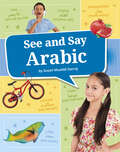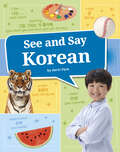- Table View
- List View
Schmegoogle
by Daniel KleinSchmegoogle: n. : a person so insignificant that if you Google his name, nothing comes up.Schmegoogle: Yiddish Words for Modern Times is a hilariously useful lexicon of neologisms that capture the flavor of life as we live it today.This clever book introduces more than 200 new terms rooted in real Yiddish, accompanied funny use-it-in-a-sentence examples and entertaining etymology.• Yiddish has long enriched English language slang.• Covers subjects including technology, family, dating, anxiety, insults and more• All terms are a unique blend of classic Yiddish with modern topicsIn this fast-changing modern world experienced online and through apps, of foodies, legal weed, and shifting social constructs, our need for the expressive wonders of Yiddish has never been greater. Bothered by that unanswered drift of e-mail piling up (e-charazi), stuffed by food or worry (gifilted), feeling like the dating app sends in only clowns (a zhlub magnet)? Schmegoogle is here to help.• Hilarious useful Yiddish neologisms for the 21st century• Makes a great gift for Jewish holidays or anyone who loves Jewish humor, as well as language nerds.• Perfect to for any occasion• You'll love this book if you love books like Yiddish with Dick and Jane by Ellis Weiner and Barbara Davilman, Born to Kvetch: Yiddish Language and Culture in All of Its Moods by Michael Wex, and Yiddish with George and Laura by Ellis Weiner, Barbara Davilman.
Scholastic Read XL (Grade #7)
by ScholasticIt's the first day of seventh grade. Will Victor make a good impression on the girl of his dreams?
Scholastic Read XL (Grade #8)
by ScholasticSurveys can be a great way to learn about people's opinions and habits. But when you read the results of a survey, there are some details you should check.
Scholastic Read XL, Grade 6, Level 1: Student Anthology
by ScholasticScholastic Read XL, Grade 6, Level 1: Student Anthology is a school textbook, full of short stories with discussion questions at end of each story.
Schottenfreude: German Words for the Human Condition
by Ben SchottSchottenfreude is a unique, must-have dictionary, complete with newly coined words that explore the idiosyncrasies of life as only the German language can.Ever thought, There should be a German word for that? Well, thanks to the brilliantly original mind behind Schott&’s Original Miscellany, now there is. In what other language but German could you construct le mot juste for a secret love of bad foods, the inability to remember jokes, Sunday-afternoon depression, the urge to yawn, the glee of gossip, reassuring your hairdresser, delight at the changing of the seasons, the urge to hoard, or the ineffable pleasure of a cold pillow? A beguiling, ideal gift book for the Gelehrte or anyone on your list—just beware of rapidly expanding (and potentially incomprehensible) vocabularies.
Science and the Human Comedy: Natural Philosophy in French Literature from Rabelais to Maupertuis
by Harcourt BrownNew scientific theories, methods, and objectives exert subtle and often unnoticed influences on literary creation. The developments of the attitudes and aspirations of French scientists between the Renaissance and the Revolution and the impact of these new outlooks on French literature form the theme of this book by an authority in the interdisciplinary treatment of science and literature. Implicit in the author's exploration is the view that in the development of the scientific revolution there was no overall design, but rather random growth; human beings turn up at various moments, some of them appropriately, some of them not, so that the record is in part a story of successful endeavour, in part a comedy little short of farce. in the historical panorama of this book, four auhors, each known for his ironic, even comic, insight into the human condition, are chosen to illustrate the theme. As men of letters, Rabelais and Voltaire exhibit well-defined scientific interests, while Pascal and Maupertuis were drawn from their scientific vocations into the discussion of ideas in literary forms. Consideration of their similarities and differences suggested the title, Science and the Human Comedy. This work is a valuable contribution to our understanding of the historical and cultural conditions accompanying the advancement of science in a critical period, as well as of several ways in which the process was reflected, sometimes directly, more often indirectly, in literature. (University of Toronto Romance Series 30)
Scottish Gaelic: A Comprehensive Grammar (ISSN)
by William LambScottish Gaelic: A Comprehensive Grammar is a definitive description of contemporary Gaelic.The volume presents an authoritative account of modern Gaelic grammar, attending to both idealised usages – as typically taught in formal education – and more colloquial forms. Core chapters include useful observations about dialectal and register differences, such as variations in inflection, pronunciation and word forms. The book also demystifies nuances of the language that many users find opaque, according to recent research. In each chapter, the most important, basic information is presented first (e.g. standard verb conjugations), followed by increasingly detailed information for more advanced users. This way, the book addresses the diverse needs of its intended audience. Brimming with authentic examples, the volume accommodates readers of all levels, from complete beginners to professional linguists. It is both an ideal textbook for structured coursework and an indispensable companion for independent study.
Scribblers, Sculptors, and Scribes: A Companion to Wheelock's Latin and Other Introductory Textbooks
by Richard A. LaFleurAn outstanding and enjoyable companion reader to the Wheelock’s curriculum, or any introductory Latin textbook.From one of the country’s leading Latinists, this reader is the perfect complement to any Latin program, and the first collection of entirely authentic classical Latin texts that beginning students, from the very first day of their introduction to Latin, can read and enjoy.Beginning with simple graffiti, Scribblers, Sculptors, and Scribes moves toward longer inscriptions and literary texts as students progress. Designed to accompany the bestselling Wheelock’s curriculum, its 40 chapters are linked with the 40 chapters of Wheelock’s Latin, but the book’s readings and design features make it suitable for use alongside any introductory college or high-school Latin textbook. Packed with hundreds of actual Latin inscriptions, proverbs, and texts, this outstanding textbook also includes dozens of photos and illustrations, maps, discussion and comprehension questions, grammar capsules, a Latin–English vocabulary section, a summary of forms, and much more.
Second Language Acquisition Processes in the Classroom: Learning Japanese (Second Language Acquisition Research Series)
by Amy Snyder OhtaThis book is the first study to examine how interactional style develops within the walls of a foreign language classroom in the first two years of language study. Results show learners to be highly sensitive to pragmatic information and that learners can move toward an appropriate interactional style through classroom interactive experience. The book shows how learners are most often sources who offer assistance and correction, with errors serving most often to stimulate further thinking about what form is correct. Analysis shows learners to be active in seeking corrective information in the classroom setting, not only from peer partners but also from the teacher. They are active in noticing how the teacher's utterances--even when addressed to others--contrast with their own, and utilize corrective feedback intended for other students. In addition, the results show that teacher-initiated corrective feedback addressed to individual learners is only one source of corrective feedback. Learners are shown to be active in both teacher-fronted and peer interactive settings. In newer L2 teaching methodologies which focus on the use of peer interactive tasks, the teacher's role has been de-emphasized. This book, however, shows how important the teacher's role is. The final chapter examines how the teacher can act to maximize the benefits of peer interactive tasks through how they design tasks and present them to the class. First, the chapter looks at how learners use English--their L1--in the classroom, concluding that how teachers present activities to the class has an impact on the amount of L1 used by students during peer interaction. Following up on this finding, the chapter works to address questions that teachers face in lesson planning and teaching. It presents a useful list of questions teachers can ask when designing peer interactive tasks in order to maximize the effectiveness of a wide variety of language learning tasks.
Second Language Acquisition and the Critical Period Hypothesis (Second Language Acquisition Research Series)
by David BirdsongSecond Language Acquisition and the Critical Period Hypothesis is the only book on the market to provide a diverse collection of perspectives, from experienced researchers, on the role of the Critical Period Hypothesis in second language acquisition. It is widely believed that age effects in both first and second language acquisition are developmental in nature, with native levels of attainment in both to be though possible only if learning began before the closure of a "window of opportunity" – a critical or sensitive period. These seven chapters explore this idea at length, with each contribution acting as an authoritative look at various domains of inquiry in second language acquisition, including syntax, morphology, phonetics/phonology, Universal Grammar, and neurofunctional factors. By presenting readers with an evenly-balanced take on the topic with viewpoints both for and against the Critical Period Hypothesis, this book is the ideal guide to understanding this critical body of research in SLA, for students and researchers in Applied Linguistics and Second Language Acquisition.
Second Language Acquisition: An Introductory Course
by Susan M. Gass Jennifer Behney Luke Plonsky Elizabeth HuntleyNow in its sixth edition, this bestselling textbook remains the cornerstone for the study of second language acquisition, providing a comprehensive yet accessible introduction to SLA.This substantially revised and updated edition has been edited into ten chapters, with a focus on the most frequently taught core themes and increased accessibility. A new introductory chapter provides a concise overview of the history of the field. Omitted chapters are available online where supplementation is desired. The text continues to provide a rich range of pedagogical tools that encourage students to reflect upon the experiences of second language learners. As with previous editions, discussion questions and problems are peppered throughout each chapter to help students apply their knowledge, and a glossary defines and reinforces must-know terminology. Additional questions and problems appear on the online companion website.This seminal text is ideal core reading for SLA courses in second language studies, applied linguistics, linguistics, TESOL, and/or language education programs. This textbook is supported with Instructor and Student Resources, including PowerPoint slides, exercises, flashcards, audio and video links: www.routledge.com/cw/gass.
Second Language Acquisition: An Introductory Course
by Susan M. GassNow in a fourth edition, this bestselling introductory textbook remains the cornerstone volume for the study of second language acquisition (SLA). Its chapters have been fully updated, and reorganized where appropriate, to provide a comprehensive yet accessible overview of the field and its related disciplines. To reflect current developments, new sections on using learner corpora, semantics and morphosyntax (within formal approaches to SLA), sociocultural approaches, gesture, priming research, and chaos theory have been added. Students will also find expanded discussions of heritage language learning, bilingualism, pragmatics, and much more. The redesigned fourth edition of Second Language Acquisition retains the features that students found useful in the current edition but also provides new pedagogical tools that encourage students to reflect upon the experiences of second language learners. As with previous editions, discussion questions and problems at the end of each chapter help students apply their knowledge, and a glossary defines and reinforces must-know terminology. This clearly-written, comprehensive, and current textbook, by expert Sue Gass, is the ideal textbook for the introductory SLA course in second language studies, applied linguistics, linguistics, TESOL, and language education programs.
Second Language Learning and Language Teaching
by Vivian CookThe fourth edition of this classic textbook has been revised to reflect recent developments in language teaching and learning yet retains the basic structure and approach so popular with its readers. Teaching and learning content has been updated, particularly taking into account the rise of task-based learning, Conversational Analysis and social models of second language acquisition, changes in national syllabuses and examinations and the increasing controversy over the role of the native speaker target. Each chapter has been revised to stand alone, enabling the text to be taught and studied out of sequence if preferred. A set of focusing questions has also been added to each and further reading sections have been updated. Second Language Learning and Language Teaching remains the essential textbook for all student teachers of modern languages and TESOL as well as applied linguistics.
Second Language Learning through Drama: Practical Techniques and Applications
by Joe WinstonDrama is increasingly being recognised as a valuable pedagogy for language learning as it can harness children‘s imaginations and stimulate their desire to communicate. Second Learning Language through Drama draws on current theories of additional and foreign language learning and illustrates through practical case studies how drama can be used to support the four key skills of listening, speaking, reading and writing. Drawing on the work of an international group of practitioners who are all highly experienced in using drama for the purpose of second language learning, the book clearly explains key drama conventions and strategies and outlines the innovative ways they have been used to create enjoyable and stimulating classroom activities that allow for multiple ways of learning. Throughout the book the emphasis is on making language learning accessible and relevant to children and young people through creative, physically active and playful approaches. The strategies described are all highly flexible and readily adaptable to different teaching contexts. Specific themes include: Using stories and drama to motivate learners at all levels Drama, language learning and identity Assessment opportunities through process drama Issues of language learning and cultural empowerment Digital storytelling Film & drama aesthetics Second Language Learning through Drama will be of great interest to those studying on undergraduate and postgraduate courses and will serve as a highly valuable text to practitioners looking to incorporate the approaches described into their lessons and classroom activities.
Second Language Pragmatics and English Language Education in East Asia (Routledge Research in Language Education)
by Cynthia LeeThis edited collection addresses the link between second language pragmatics (including interlanguage and intercultural) research and English language education. The chapters use different contemporary research methods and theoretical frameworks such as conversation analysis, language-learners-as-ethnographers, discourse and interactional approaches and data in contexts (either in the region or overseas). The content explores and discusses the significance of learning and teaching of second language (L2) pragmatics in language education for learners who use English as a lingua franca for academic and intercultural communication purposes with native and non-native speakers of English, focusing on pragmatic actions, social behaviours, perceptions and awareness levels in three regions in East Asia – China, Japan and South Korea. It is an important contribution to the area of second language pragmatics in language education for East Asian learners. It recommends research-informed pedagogies for the learning and teaching of interlanguage or intercultural pragmatics in regions and places where similar cultural beliefs or practices are found. This is an essential read for researchers, language educators, classroom teachers, readers who are interested in second language pragmatics research and those interested in second language acquisition and English language education in the East Asian context.
Second Language Processing: An Introduction (Second Language Acquisition Research Series)
by Nan JiangSecond Language Processing: An Introduction is the first textbook to offer a thorough introduction to the field of second language processing (SLP). The study of SLP seeks to illuminate the cognitive processes underlying the processing of a non-native language. While current literature tends to focus on one topic or area of research, this textbook aims to bring these different research strands together in a single volume, elucidating their particularities while also demonstrating the relationships between them. The book begins by outlining what is entailed in the study of SLP, how it relates to other fields of study, and some of the main issues shared across its subareas. It then moves into an exploration of the three major areas of current research in the field—phonological processing, lexical processing, and sentence processing. Each chapter provides a broad overview of the topic and covers the major research methods, models, and studies germane to that area of study. Ideal for students and researchers working in this growing field, Second Language Processing will serve as the go-to guide for a complete examination of the major topics of study in SLP.
Second Language Research: Methodology and Design
by Alison Mackey Susan M. GassIn this second edition of the best-selling Second Language Research, Alison Mackey and Sue Gass continue to guide students step-by-step through conducting the second language research process with a clear and comprehensive overview of the core issues in second language research. Supported by a wealth of data examples from actual studies, the book examines questions of what is meant by research and what defines good research questions, covering such topics as basic research principles and data collection methods, designing a quantitative research study, and concluding and reporting research findings. The second edition includes a new chapter on mixed-methods, new "time to think" and "time to do" text boxes throughout, and updates to reflect the latest research and literature. Supplementary materials, including an extensive glossary and appendices of forms and documents that students can use in conducting their own studies, serve as useful reference tools, with suggestions on how to get research published reemphasizing the book’s practical how-to approach. Second Language Research, Second Edition is the ideal resource for understanding the second language research process for graduate students in Second Language Acquisition and Applied Linguistics.
Second Language Research: Methodology and Design
by Alison Mackey Susan M. GassSecond Language Research: Methodology and Design is a clear, comprehensive overview of core issues in L2 research. Authored by well-known scholars in SLA and supported by a wealth of examples from actual studies and extensive pedagogical resources, this book first introduces students to the key topics and debates in L2 research. It then guides readers step by step through the research process—from basic principles and collection methods through study design and reporting—to the point of being able to conduct their own research from beginning to end. This book is an essential text for students and novice researchers of SLA, applied linguistics, and second and foreign language teaching. Key Features A wealth of graphics, visuals, and exercises in each chapter. "Time to Think" and "Time to Do" boxes within chapters Helpful glossary and subject index New to This Edition Substantially reorganized chapters Significantly expanded chapters on qualitative and mixed methods Substantive revised material on computer/technology-based research Spotlights a variety of new software packages and databases, including video-mediated technology and games Discusses the Open Science Movement Expanded coverage of corpora, processing, and psycholinguistics-based research Updated references throughout
Second Language Teacher Education: A Sociocultural Perspective (ESL & Applied Linguistics Professional Series)
by Karen JohnsonThis book presents a comprehensive overview of the epistemological underpinnings of a sociocultural perspective on human learning and addresses in detail what this perspective has to offer the field of second language teacher education. Captured through five changing points of view, it argues that a sociocultural perspective on human learning changes the way we think about how teachers learn to teach, how teachers think about language, how teachers teach second languages, the broader social, cultural, and historical macro-structures that are ever present and ever changing in the second language teaching profession, and what constitutes second language teacher professional development. Overall, it clearly and accessibly makes the case that a sociocultural perspective on human learning reorients how the field understands and supports the professional development of second language teachers.
Second Language Writers' Text: Linguistic and Rhetorical Features (ESL & Applied Linguistics Professional Series)
by Eli HinkelThis comprehensive and detailed analysis of second language writers' text identifies explicitly and quantifiably where their text differs from that of native speakers of English. The book is based on the results of a large-scale study of university-level native-speaker and non-native-speaker essays written in response to six prompts. Specifically, the research investigates the frequencies of uses of 68 linguistic (syntactic and lexical) and rhetorical features in essays written by advanced non-native speakers compared with those in the essays of native speakers enrolled in first-year composition courses. The selection of features for inclusion in this analysis is based on their textual functions and meanings, as identified in earlier research on English language grammar and lexis. Such analysis is valuable because it can inform the teaching of grammar and lexis, as well as discourse, and serve as a basis for second language curriculum and course design; and provide valuable insight for second language pedagogical applications of the study's findings.
Second and Foreign Language Education
by Stephen May Nelleke Van Deusen-SchollIn this third, fully revised edition, the 10 volume Encyclopedia of Language and Education offers the newest developments, including an entirely new volume of research and scholarly content, essential to the field of language teaching and learning in the age of globalization. In the selection of topics and contributors, the Encyclopedia reflects the depth of disciplinary knowledge, breadth of interdisciplinary perspective, and diversity of socio-geographic experience in the language and education field. Throughout, there is an inclusion of contributions from non-English speaking and non-western parts of the world, providing truly global coverage. Furthermore, the authors have sought to integrate these voices fully into the whole, rather than as special cases or international perspectives in separate sections. The Encyclopedia is a necessary reference set for every university and college library in the world that serves a faculty or school of education, as well as being highly relevant to the fields of applied and socio-linguistics. The publication of this work charts the further deepening and broadening of the field of language and education since the publication of the first edition of the Encyclopedia in 1997 and the second edition in 2008.
Second and Foreign Language Learning Through Classroom Interaction
by Joan Kelly Hall Lorrie Stoops VerplaetseThis volume brings together the current theoretical interest in reconceptualizing second and foreign language learning from a sociocultural perspective on language and learning, with practical concerns about second and foreign language pedagogy. It presents a set of studies whose focus is on the empirical description of particular practices constructed in classroom interaction that promote the learning of a second or foreign language. The authors examine in detail the processes by which the learning of additional languages is accomplished in the interaction of a variety of classrooms and in a variety of languages. Not only will the findings from the studies reported in this volume help to lay a foundation for the development of a more expansive, sociocultural model of second and foreign language learning, but on a more practical level they will help language educators in creating a set of principles for identifying and sustaining classroom interactional practices that foster additional language development. The volume is distinguished in three ways: * Following a Vygotskyan perspective on development, the studies assume that language learning is a fundamentally pragmatic enterprise, intrinsically linked to language use. This breaks from a more traditional understanding of second and foreign language learning, which has viewed learning and use as two distinct phenomena. The importance of classroom interaction to additional language development is foregrounded. * The investigations reported in this book are distinguished by their methodological approach. Because language learning is assumed to be a situated, context-sensitive, and dynamic process, the studies do not rely on traditional experimental methods for collecting and analyzing data, but rather, they involve primarily the use of ethnographic and discourse analytic methods. * The studies focus on interactional practices that promote second and foreign language learning. Although a great deal of research has examined first language learning in classrooms from a sociocultural perspective, little has looked at second and foreign language classrooms from such a perspective. Thus there is a strong need for this volume of studies addressing this area of research. Researchers, teacher educators, and graduate students across the fields of second and foreign language learning, applied linguistics, and language education will find this book informative and relevant. Because of the programmatic implications arising from the studies, it will also appeal to teacher educators and teachers of second and foreign languages from the elementary to the university levels.
Secondary School English Education in Asia: From policy to practice (Routledge Critical Studies in Asian Education)
by Bernard Spolsky Kiwan SungContinuing on from the previously published Primary School English-Language Education in Asia: From Policy to Practice (Moon & Spolsky, 2012), this book compiles the proceedings which took place at the 2011 annual conference of AsiaTEFL which took place in Seoul, Korea. It surveys the current status, practices, challenges, and future directions of Secondary English education in 11 diverse countries - in Israel, Japan, Korea, Singapore, Bangladesh, India, Indonesia, Malaysia, Pakistan, Vietnam and China. Given the importance of secondary English education as the central feature for continuing development of target language and culture in English language teaching in Asia, each contributed chapter includes key policies, theories, and practices related to the development and implementation of country-specific curricular and instructional programs in secondary English educational contexts in these countries. Secondary School English Education in Asia: From Policy to Practice critically analyses both sides of the English language debate – from advantages to complications – in its chapters including: Educating for the 21st Century: The Singapore Experience Miles to Go …: Secondary Level English Language Education in India English Language Education Innovation for the Vietnamese Secondary School: The Project 2020 Exploring the Value of ELT as a Secondary School Subject in China: A Multi-goal Model for English Curriculum Secondary School English Education in Asia will appeal to English Language Teaching (ELT) researchers, teacher educators, trainee teachers and teachers, primarily those teaching in Asia.
See and Say Arabic (Learn a Language!)
by Susan Muaddi DarrajOffering simple phrases and key vocabulary, this book will help readers start learning Arabic.
See and Say Korean (Learn a Language!)
by Aerin ParkOffering simple phrases and key vocabulary, this book will help readers start learning Korean.
